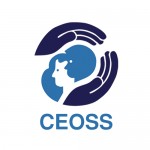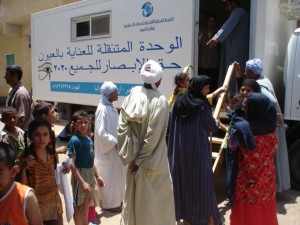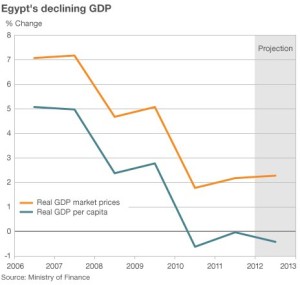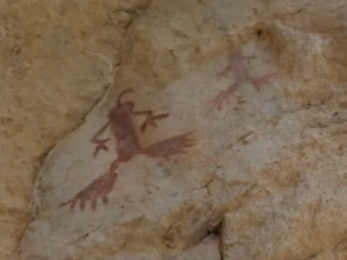Prior to the Egyptian military’s coup d’état in July 2013, Coptic Evangelicals were faced with rising hostilities directed at the country’s ancient Christian community. This took place amid widespread unrest and a shattered economy. The Coptic Evangelical Organization for Social Services (CEOSS) forms this community’s most visible position in Egyptian society. While the political circumstances in Egypt have changed dramatically since this report was written, it offers a snapshot of how Coptic Evangelicals in Egypt have found ways to survive and thrive in spite of crushing circumstances. Today, CEOSS continues as one of the country’s most important development organizations.
CEOSS and Post-Revolution Development Challenges in Egypt
The Coptic Evangelical Organization for Social Services recently released a video on their YouTube channel called “The Accident.” 1 It’s set in Cairo’s chaotic and dangerous traffic scene, which is familiar to Egyptians. In the screenplay, a woman is injured after her car is struck in an intersection. A crowd gathers around the scene, and begins arguing about what to do. One man says he cannot help the unconscious woman out of the car because it is religiously forbidden to touch a woman who is not a relative. Another man offers a religious counter-argument. A woman in the crowd blames the driver for the accident. At the edge of the crowd, a news reporter offers an outlandish report about a drunken woman who passed out in an intersection. Other bystanders offer various excuses for not taking the woman to safety. Finally, the entire crowd runs away when a child points out that leaking fuel is about to cause an explosion. The woman is left to die in the car.
The video then quickly plays in reverse to the beginning of the accident. When it rolls forward again, each person in the group contributes a solution to the crisis. The woman is saved, and a patrolman is posted at the intersection to prevent further accidents.
The video is presented as a metaphor for the current crisis in Egypt. It also indicates the direction CEOSS is attempting to steer their mission as the promise of the Arab Spring in Egypt gives way to enormous economic, human rights, and governance challenges. To the bystanders in the video, it is obvious to everyone in the community that something has gone wrong, and something needs to be done immediately. However, the message of the video is that the answer lies not in arguing or finger pointing. Rather, if each person does his or her part in finding a solution, the dangerous situation will be overcome. The message of the video meshes well with the rhetoric and re-focusing CEOSS is doing in light of the growing challenges after the Arab Spring.
 Coptic Evangelicals in Egypt hold a unique place in the country’s population. As of 2011, there are about 250,000 Protestants in Egypt, including Coptic evangelicals. 2 Their population is tiny compared to the 10 to 14 million Coptic Orthodox, and 80 million Muslims in Egypt. Despite their numbers, they have a significant presence in Egypt’s domestic development scene via CEOSS, one of Egypt’s largest social service organizations (CEOSS).
Coptic Evangelicals in Egypt hold a unique place in the country’s population. As of 2011, there are about 250,000 Protestants in Egypt, including Coptic evangelicals. 2 Their population is tiny compared to the 10 to 14 million Coptic Orthodox, and 80 million Muslims in Egypt. Despite their numbers, they have a significant presence in Egypt’s domestic development scene via CEOSS, one of Egypt’s largest social service organizations (CEOSS).
This study examines the question: “To what extent has the 2011 Revolution and subsequent political developments affected the mission of CEOSS?” Like all nongovernmental and civil society institutions in Egypt, the 2011 revolution has certainly had an impact on CEOSS. Political events are moving quickly in the country. As such, projecting the fate of development organizations can be tricky. However, a close look at some of the trends with respect to the current situation in Egypt will help identify what is ahead for this and similar organizations.
Presentation Slides:
History
Coptic Evangelicals have their roots in the 19th century Presbyterian missionary movement. In 1854 a group of missionaries from the Midwestern United States arrived in Egypt. They were part of a large movement of American and British evangelicals fanning out across the globe with the hope of spreading the Christian Gospel to every country. The missionaries who came to Egypt in the 1850’s were members of the United Presbyterian Church of North America. The denomination, based in Pittsburgh, had roots among descendants of Scottish immigrants to the United States. It was staunchly abolitionist during the American Civil War, and worked with freed slaves afterward. In the United States their work with “freedmen’s missions” helped diversify the movement beyond its rural Scottish roots. 3 In Egypt, the lasting institutions of the Presbyterian missionary efforts are seen today in the Coptic Evangelical Church, CEOSS, as well as the American University in Cairo. 4
In Egypt, Presbyterian missionaries experienced a period of adjustment in finding a receptive audience for their call to conversion. Upon arriving in Egypt, they found that the lower Nile region, including the city centers of Cairo and Alexandria, were nearly completely Muslim. Social, legal and religious restrictions made proselytizing among Muslims particularly difficult. There were a number of Coptic Orthodox Christians in this area, but they were mostly well-educated government workers with little interest in switching their religious affiliation. 5
 The missionaries then directed their resources to Upper Egypt, with its larger population of rural fellahin Coptic Christians. The missionaries travelled up and down in the Nile in riverboats, and became known as “Riverboat Missionaries” to the locals. 6 By the turn of the century, the Presbyterian missionaries had established fifty congregations serving more than 6,500 Coptic evangelicals, and had begun moving the care of the Egyptian church to local leaders. 7 This degree of missionary success early in the history of the Coptic Evangelical community is reflected in the high level of interest and activity CEOSS continues today in the region.
The missionaries then directed their resources to Upper Egypt, with its larger population of rural fellahin Coptic Christians. The missionaries travelled up and down in the Nile in riverboats, and became known as “Riverboat Missionaries” to the locals. 6 By the turn of the century, the Presbyterian missionaries had established fifty congregations serving more than 6,500 Coptic evangelicals, and had begun moving the care of the Egyptian church to local leaders. 7 This degree of missionary success early in the history of the Coptic Evangelical community is reflected in the high level of interest and activity CEOSS continues today in the region.
By the end of the Suez crisis in 1956, most foreign missionaries had left the country. Two years, later, the Coptic Evangelical church was recognized as an independent Presbyterian synod. One former missionary defined the new, more equal, relationship between the American and the Egyptian church: “They are not now our children. They are our sister churches in Christ and join us in being witnesses to the whole world.” 8
The Coptic Evangelical Organization for Social Services had its roots in the late 1940’s as a village literacy program run by Presbyterian missionaries. Rev. Samuel Habib established CEOSS in 1952. Its services soon expanded to include a variety of programs. These early development efforts ranged from agricultural education to small business development. 9 Today, CEOSS has grown into a large and influential NGO with a wide array of services.
The Mission of CEOSS
 At the foundation of CEOSS’s mission is what the organization refers to as rights-based development. This approach seems not only to alleviate poverty or solve a particular issue such as illiteracy or poor healthcare. In a nutshell, it also entails empowering those benefiting from the program to have a greater say in their own affairs. This includes participation in local government as citizens, better governance, improved laws that promote development and human rights, and so on. A rights-based approach recognizes that many, if not all, development goals are intertwined with a human right, such as those defined in the Universal Declaration of Human Rights. 10 For example, improving education goes hand in hand with a right to education, improved health services are a manifestation of a right to adequate health and well-being, etc. 11
At the foundation of CEOSS’s mission is what the organization refers to as rights-based development. This approach seems not only to alleviate poverty or solve a particular issue such as illiteracy or poor healthcare. In a nutshell, it also entails empowering those benefiting from the program to have a greater say in their own affairs. This includes participation in local government as citizens, better governance, improved laws that promote development and human rights, and so on. A rights-based approach recognizes that many, if not all, development goals are intertwined with a human right, such as those defined in the Universal Declaration of Human Rights. 10 For example, improving education goes hand in hand with a right to education, improved health services are a manifestation of a right to adequate health and well-being, etc. 11
CEOSS identifies rights-based outcomes as “participation in decision-making, providing better opportunities for developing human capabilities, and releasing humanity from confining boundaries and increasing community self-reliance.” 12 In addition to programs that, for example, improve education itself or provide better medical care, CEOSS also engages elected local governing bodies, public ministries, private companies, and Egyptian media to help secure the rights to the service area they pursue. 13
Development Programs
The scope of CEOSS’s development work is spread across a spectrum of more than a dozen areas, including agriculture, economic development, civic education, people with disabilities, and many others. Though CEOSS is an organization based in a Protestant denomination, they offer their development services to adherents of every faith in Egypt, including many Muslims. Among their biggest projects is the Horus Eye Hospital in Minya, Upper Egypt. 14
The hospital was established in 2010 to address the high rates of cataracts and other treatable eye diseases in a region of Egypt that does has few advanced medical facilities. In 2011, the hospital has examined more than 2,000 patients, and performed more than 300 surgeries. 15
CEOSS also targets the concerns of women and girls, promoting the enrollment of girls in school by providing scholarships and transportation. This is a particular concern in Upper Egypt where roughly 50 percent of girls ages 10 to 14 can read and write. 16 CEOSS also takes a holistic approach to the improvement of women and girls in rural areas by engaging a number of issues with local authorities to address concersn such as early and forced marriages, female genital cutting and other practices. According to one independent report, five communities voluntarily stopped FGC through initiatives organized by CEOSS. 17
In terms of economic development, CEOSS works in urban areas, such as Cairo, as well as rural regions to improve the livelihoods of the population it serves. Programs include establishing job-seekers database, vocational training, interviewing and resume writing, and help to young entrepreneurs in starting businesses. 18 CEOSS also has an active micro-credit program. In 2011, they disbursed nearly 57,000 small loans to nearly 40,000 active clients. Sixty-four percent of the loans were to poor women and households headed by women. CEOSS claims a repayment rate of 98.7 percent. 19
These are just a few examples of development programs that CEOSS is using to improve the lives of the poor and disadvantaged in Egypt. By all accounts, the organization has a solid reputation for delivering the services they promise. For example, Habitat for Humanity celebrated the completion of a large housing project in cooperation with CEOSS, praising the organization in its press release about the successful partnership: “CEOSS is an experienced and effective development organization. In both Christian and Muslim communities, CEOSS staff work to develop local leadership, determine needs and facilitate programs that lead to better health, education and economic development.” 20
Post-Revolution Egypt
Overthrowing the Mubarak regime was a violent and difficult task that galvanized the Egyptian people toward establishing a democratic government. However, the task of building a new state over the past two years has proved very difficult. The most significant development is the ascendency of the Muslim Brotherhood’s Freedom and Justice party in national elections following the revolution. Worries about the Brotherhood’s commitment to democratic ideals and some of the party’s actions since the revolution seem to have confirmed some fears in the West and among secular Egyptians that the days of oppressive government are not over in Egypt. 21
Yet, the challenges Egyptians face go well beyond the religious roots and political agenda of the party in power. For example, Egypt’s economic struggles seem to be rising. The nation’s foreign reserves have dropped from $36 billion to about $13 billion. Even this number may be inflated, reflecting about $5 billion contributed by Qatar, Saudi Arabia and Turkey to help stabilize the country’s growing cash problems. 22 Billions of dollars in multilateral aid are awaiting the government’s construction of a viable economic plan. 23
Compounding the impact of Egypt’s growing cash problem is the dramatic drop in a mainstay of the Egyptian economy: tourism. By the end of 2010, more than 14 million foreign visitors arrived in Egypt. By the end of 2011, that number had dropped to less than ten million. 24 In the last few years of the Mubarak regime before the revolution, tourism had helped buffer the impact of the global economic downturn, and the government was preparing to pour a portion of the nation’s growing revenue into building up the tourism sector. 25 According to the Bank of Alexandria, Egyptians employed in the tourism industry accounted for about 12 percent of the nation’s workforce. Revenues from foreign tourism brought more than $11.5 billion in 2010, and the trend was headed upward until 2011. 26
A recent World Economic Forum report on global travel and tourism summed up the ills that are making tourists wary of travel to Egypt over the past two years: “Egypt is ranked 10th regionally, dropping 10 positions in the global assessment to reach 85th overall, probably the result of the continuing unrest in the country. Most notably, the evaluation of the safety and security environment has dropped to the lowest position of all countries covered in the Report (140th).” (Those who brave the safety and logistical concerns in Egypt are rewarded with low prices on hotels, food and transportation.) 27

Foreign investment has also seen a “tremendous” drop since the revolution. Political unrest and new restrictions imposed by the current government on the transfer of funds into and out of the country are blamed for changing the investment climate to the point that foreign investment dollars have all but evaporated. 28
Unemployment has edged up to nearly 13 percent from around 11 percent before the revolution. 29 However, the unemployment rate for Egyptians aged 15 to 29 (one of the core demographics driving the revolution) has reached 25 percent. 30 In all, about 3.5 million Egyptians are out of work, and GDP growth has slowed to just over two percent. 31 The poverty rate has also increased from 21.6 percent to 25.2 percent. More than 80 percent suffering from poverty and associated problems (including illiteracy, education disparities, etc) live in Upper Egypt, where CEOSS conducts many of its key programs. 32
CEOSS After The Revolution
On January 19, 2013, the Egyptian government held the first NGO forum in Cairo. President Morsi stopped by the CEOSS Pavilion during the event. Zaki gave him an overview of the history of the organization and their key projects. According to CEOSS, Morsi expressed his support for the organization and the active role it plays in Egyptian society. 33
On March 26, 2013, Egypt’s Shura Council, the upper house of the Egyptian parliament, considered a controversial new law governing the activities of foreign and domestic non-governmental organizations. 34 The new law was widely criticized abroad. It also has the highest potential impact on the mission and operations of CEOSS since the revolution. The U.N. Office of the High Commissioner for Human Rights condemned the new law for treating NGO funds as public money, and banning funding from abroad without prior permission from the Egyptian government. The OHCHR also criticized the law’s provision that a government official or individual could veto funding or projects as an undue intrusion on the freedom of an organization to conduct business according to its own principles and agenda. The office also pointed out that the draft law prohibits the registration of foreign non-governmental organizations that receive ‘governmental funds directly or indirectly’ and carry out activities that may not be in the interest of the party in power. 35
The International Center for Not-for-Profit Law released a laundry list of issues they assessed are antithetical to encouraging a culture of development in Egypt. Here is a sample of ICNPL’s concerns:
- The powerful new government “Coordinating Committee” has broad discretion to deny registration and activities.
- The law subjects foreign organizations to excessive government interference.
- Egypt has the right to veto funds obtained outside Egypt, but does not specify criteria for rejecting funds.
- The law limits the number of foreign persons who may be in the board of a domestic organization, violating the International Covenant on Civil and Political Rights.
- If a court ultimately finds that “public funds” have been misused, it can impose severe penalties – more severe than if the funds are considered private.
These and other restrictions, as well as potential imprisonment over funding and personnel disputes, have worried many in the development community in Egypt. However, many of restrictions in the NGO law reflect the deep suspicion Egyptian politicians have toward the involvement of foreign organizations in Egypt. A remark from Nagi El-Shehabi, a member of the Shura Council from the Democratic Generation Party, encapsulates this distrust: “Most foreign NGOs in Egypt are, in fact, espionage cells spying on Egypt for the US and Israel … I see this new law as crucial to Egypt for eliminating the spies who have infiltrated the country under the cover of foreign ‘NGOs.” 36
Some Egyptian activists say the new law effectively hampers efforts to bring their country into compliance with international human rights agreements. Mohamed Zaree of the Cairo Institute for Human Rights Studies (CIHRS), said, “There’s no hope for those that work in human rights or criticize the government on human rights to obtain foreign funding.” 37
Even though the law has polarized the Egypt’s political and human rights communities, Dr. Andrea Zaki, the General Director of CEOSS, expressed public support for the new NGO law in prominent Egyptian newspapers. The day before the proposed law went before the Shura Council, Zaki said, “I think that this law would be a ‘leap’ in civil society.” 38 The next day, Zaki told another newspapaper, “I am convinced that the picture is not all bleak, and hope develops if everyone carries some responsibility.” 39
In an official statement after the new law passed the Shura Council, Zaki expressed optimism: “A general positive shift in mission has come over civil society organizations in Egypt since the revolution began, and CEOSS is not excluded from this.” Even so, certain parts of his statement indicated concern for the future of the organization and the people it serves: “Our focus on development has been shifted to empowerment and protection of human rights.” 40
The difference between Zaki’s statements of support and the rhetoric from those concerned about the new NGO law may reflect a strategic move on the part of CEOSS. The concerns for development and civil society organizations are well documented. However, it may not be in the strategic interests of CEOSS to position themselves publically against the government or against the laws that directly affect their operations. Events over the past two years have made the services that CEOSS provides for the poor and underprivileged more in need than prior to the revolution. It makes a certain degree of sense that if a government committee will have veto power over funding and programs, then positioning CEOSS as a good will partner is the right thing to do.
CEOSS recent rhetoric, including Zaki’s statements, the “Accident” video, and other examples, may also reflect a deeper understanding of the perennial challenges that CEOSS has faced in building itself as an effective Egyptian organization over the past six decades. Survival as a large development organization with its foundation in a tiny religious community with limited rights under an autocratic regime has certainly provided some important lessons.
On April 12th, about 500 CEOSS workers attended an organization-wide staff meeting. The theme of the meeting was “I am Free.” The meeting discussed topics such as the concept of freedom, different forms of freedom, and the relationship between personal responsibility and freedom. This theme can be seen as an extension of the attitude CEOSS is projecting about their role in solving Egypt’s development challenges. Just as in “The Accident” video, the message CEOSS seems to be delivering is that those who are witnessing the problem have a choice to complain and seek blame, or work together to find a solution despite the circumstances.
To what extent has the 2011 Revolution and subsequent political developments affected the mission of CEOSS? Overall, it has heightened the need for their services. More directly, it has focused the organization’s emphasis on rights-based development, while tempering their rhetoric toward political changes that might make pursuit of those rights more difficult.
Notes:
- “The Accident,” CEOSS. http://youtu.be/Qvq4aQYS8ts ↩
- “Spotlight on Egypt,” Global Christianity, Pew Forum on Religion and Public Life, 19 December 2011. http://www.pewforum.org/Christian/Global-Christianity-egypt.aspx ↩
- Heather J. Sharkey. American Evangelicals in Egypt: Missionary Encounters in an Age of Empire, Princeton: Princeton University (2008), 15. ↩
- Ibid., 149. ↩
- Ibid., 20. ↩
- Ibid. ↩
- Sarah E. Gilman, “Peddling the Promise Along the Nile: the Ambivalent Mission of American Evangelicals in Egypt, 1854-1954,” Presentation: American Sociological Association annual meeting, 14 Aug 2004, 19. ↩
- Sharkey, American Evangelicals in Egypt, 202. ↩
- “PC(USA) Mission History in Egypt,” Presbyterian Mission Agency. http://www.presbyterianmission.org/ministries/global/egypt-history/ ↩
- See: Universal Declaration of Human Rights. http://www.un.org/en/documents/udhr/ ↩
- Shyama Kuruvilla, et al. “The Millennium Development Goals and Human Rights: Realizing Shared Commitments,” Human Rights Quarterly, 34-1, February 2012. ↩
- “Our Work: Local Development,” CEOSS. http://www.ceoss-eg.org/local-development/ ↩
- Ibid. ↩
- Video overview of the Horus Hospital: https://www.youtube.com/watch?feature=player_embedded&v=1jkC6td1ryE ↩
- Annual Report – 2011, CEOSS, 14. ↩
- “Community Ownership’ Spurs Girls’ Education in Egypt,” Center for Development and Population Activities, 31 January 1997. ↩
- Ibid. ↩
- Annual Report – 2011, 20. ↩
- Ibid., 24-25. ↩
- “HFH Egypt Celebrates Completion of 6,000 Houses,” (press release) Habitat for Humanity, April 2005. http://www.habitat.org/ame/stories/egypt_6000_houses.aspx ↩
- David K. Kirpatrick, “Muslim Brotherhood’s Statement on Women Stirs Liberals’ Fears,” New York Times, 14 March 2013. ↩
- “Egypt’s Economy: Going to the Dogs,” The Economist, 30 March 2013. http://www.economist.com/news/middle-east-and-africa/21574533-unless-president-muhammad-morsi-broadens-his-government-egypts-economy-looks ↩
- Ibid. ↩
- “International Tourism: Number of Arrivals,” Data, World Bank. http://data.worldbank.org/indicator/ST.INT.ARVL ↩
- Egypt’s Tourism Industry, Bank of Alexandria Economic Research Division, October 2010, 3. ↩
- Ibid., 4. ↩
- Jennifer Blanke and Thea Chiesa, eds. The Travel & Tourism Competitiveness Report 2013: Reducing Barriers to Economic Growth and Job Creation, World Economic Forum (2013), 24. ↩
- Ibid. ↩
- “2013 Investment Climate Statement,” Bureau of Economic and Business Affairs, U.S. Department of State, February 2013. http://www.state.gov/e/eb/rls/othr/ics/2013/204635.htm ↩
- Daria Solovieva, “Two Years After, Egypt’s Arab Spring And Revolution Seem Like A Long Time Ago,” International Business Times, 8 February 2013. http://www.ibtimes.com/two-years-after-egypts-arab-spring-revolution-seem-long-time-ago-1070676# ↩
- “Egypt Overview,” World Bank, 2013. http://www.worldbank.org/en/country/egypt/overview ↩
- Ibid. ↩
- CEOSS Press Release, 19 January 2013. http://www.ceoss-eg.org/the-newsletter/ ↩
- English translation of the new NGO law: http://www.icnl.org/research/library/files/Egypt/MOSS2012-En.pdf ↩
- “Egypt: NGO Bill infringes international standards – UN rights experts urge legislators to reject it,” United Nations Human Rights, Office of the High Commissioner for Human Rights,” 28 March 2013. http://www.ohchr.org/EN/NewsEvents/Pages/DisplayNews.aspx?NewsID=13190 ↩
- Gamal Essam El-Din, “Egypt’s Shura Council rubber-stamps two key bills on elections, protest rights,” Al Ahram, 26 March 2013. ↩
- Kristin Chick, “Is the Muslim Brotherhood seeking to kill Egypt’s NGOs?” The Christian Science Monitor, 22 February 2013. http://www.csmonitor.com/World/Middle-East/2013/0222/Is-the-Muslim-Brotherhood-seeking-to-kill-Egypt-s-NGOs ↩
- Safwat, Safa. “بالفيديو.. مدير الهيئة الإنجيلية: قانون الجمعيات الأهلية »جيد” (“Video: Evangelical Director says NGO Law ‘Good,”), Al-Shorouk, 25 March 2013. http://www.shorouknews.com/news/view.aspx?cdate=25032013&id=de64ecf4-5d26-443f-963c-83a305db7502 ↩
- Michael Knight, “الإنجيلية” تبحث “العبور للمستقبل” بمشاركة قيادات دينية وفكرية” (“Evangelical looking for ‘way to the future’ with the participation of religious and intellectual leaders,”), Youm 7, 26 March 2013. ↩
- “In Motion: CEOSS’ Newsletter,” 8 April 2013. http://globalministries.org/news/mee/in-motion-ceoss-newsletter.html ↩


